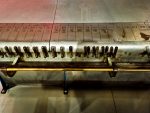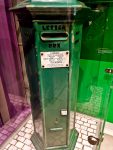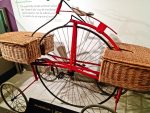Following our cartographic interlude, Heather and I’s wonderful day out continued with lunch in a nearby pub, where I had a perfectly nice bowl of chips and Heather one of the worst mac and cheese she can remember. Anyway, we weren’t there for long, for we had an appointment with a little train.

Mail Coach
From Bristol to London
Up the top of the hill, round the back of the towering Mount Pleasant postal office, amidst what is currently something of a building site, is The Postal Museum. It’s a bastion of the history of something taken almost without thought, the postal service and delivery of mail. It’s also a rather peculiar museum, as it’s split into two parts. The second part, which we toured later, is a fairly conventional, not very large, museum covering the sort of thing you’d expect (plus a bit of telephony and telegrams, given they were the purview of the Royal Mail). First however, in a different building just over and down the road a bit, is what is probably the main attraction of the entire enterprise—the chance to ride a small section of what was Mail Rail.
Mail Rail
The entry to Mail Rail feels like any other museum of the sort, with a gift shop to pass through and welcoming desk. It quickly descends (figuratively and literally) into a spartan industriousness though, white washed walls and hints of machinery in a cavernous space that feels like it might burst back into life at any moment. For this part of the museum is within the car depot of the rather remarkable Post Office Railway, latterly known as Mail Rail.

Mail Rail Train
One of the parcel carrying trains
Mail Rail isn’t just Post Office/Royal Mail history but very much transport history in its own right. The world’s first electric driverless rail system, it was designed to speedily transport mail beneath the clogged streets of London back at the start of the twentieth century. Boring of the narrow tunnels began in 1915 and, though construction was interrupted by the first world war (with the inevitable storage of museum collections in the completed tunnels), the first section opened in 1927 and things didn’t look back. The first set of rolling stock had issues with excessive wear due to the tight turns (it’s a very narrow 2 foot gauge) but the quickly introduced articulated replacement stock remained essentially unchanged though further renewals until the services eventual demise, in 2003. The driverless, automated system (originally electro-mechanical and eventually computer controlled by a system with a whole 256 kilobytes of memory) would carry mail bags and parcels between stations between strategic sorting offices which were above them (the main tunnels were deeper than the stations, giving inclines to help break and accelerate the trains, and leaving less distance to heave mail up by lift or intertwining spiral conveyors). The entire thing was remarkably long too, stretching from Stepney in the east across Whitechapel, through Liverpool Street, heading to the aforementioned Mount Pleasant, before making it’s way all the way along to Paddington at the other extreme.

Maintenance Train
Battery operated in case the power is down
As mentioned the museum actually occupies the depot at the heart of the system, where rolling stock could be maintained and repairs made (they were capable of producing a very wide number of components in house). There were also a few battery operated locos which did have a drivers cab, and could be taken out to maintain the system when it was shut down without power and to rescue stranded trains. The whole thing kept going, at its peak operating over twenty hours per day, almost without hitch. It was only really the dying off of post volumes, killed by electronic communication, and consolidation of postal sorting centres which killed it off, even then somewhat controversially. There was obviously some uncertainty, because the whole thing was simply mothballed, a skeleton maintenance crew keeping it in general working order, while someone worked out what to do with it.
Which brings us to the present. In 2013 the Postal Museum settled on opening a small section of the network to the public, offering train rides through the tunnels (I’m not sure if Parliament had to be consulted, as the original Act allowing its construction specifically prohibited the carrying of passengers so as to not be seen to compete with the commercial enterprises giving such things a good go about then). Two battery operated units were commissioned, capable of carrying the paying public through the narrow confined tunnels of the the system. Which is why Heather and I found ourselves standing in the spartan space, staring down into a tunnel waiting for the light of an oncoming train.

Little Train
Not the one we actually got on
The train, when it arrived, did not disappoint. It’s a remarkable thing, narrow with a low curved clear roof, with barely enough room to sit within (even small bags must be left behind in lockers at the platform, there simply isn’t space). Once within it feels like sitting in some futuristic space capsule, the clear sides and roof arching over, but without much room to do anything but sit forward—the warnings that this is not a ride for the claustrophobic are absolutely correct.

Wooshing Through The Tunnels
The train heads off
Moving off everything feels a lot faster than it is—the closeness of the tunnel walls and roof (and the fact they’re visible all around rather than through a window) belying the only just above walking speed of the journey. There’s an accompanying “interview” style voice over involving one of the former workers which, while a little cheesy, is at least vaguely informative and points out some of the blink and you’d have missed it things within the tunnels (sandbags to stop potential runaway trains, or abandoned stock glimpsed in a lower crossing tunnel). More entertaining are the stops at the stations, with a little video playing and the chance to see the ephemera still lying around from the brief moments of down time, like a dartboard. At one point the whole thing stops so we can be plunged into darkness, eliciting a little squeal and clutch from Heather behind me, and again emphasising this isn’t for those who can’t handle the confines.
Before we knew it the whole thing was over, suddenly emerging back where we started. It felt like we’d been gone longer than the advertised fifteen or so minutes, and gone a lot further than we evidently had (this map shows we barely got beyond the looming Mount Pleasant above).

Rail Car
Number 09
After the thrill of the train ride there was a chance to wander the rest of the depot space. There was a chance to see several examples of the rolling stock, as well as some of the work-a-day items simply left behind by the departing workers. There were also exhibits covering the above ground efforts to transport rail, the travelling post office represented in mock up form complete with wobbling floor reminiscent of the earthquake simulator at the NHM.
After another look at the little train (and convincing Heather we couldn’t just have another go) we exited through the shop, but not to leave, rather to go to the rest of the museum, the short walk down the road signposted by a postman mural peeking over the barrier surrounding one of the building sites.
The Museum

Fancy Postbox
We don’t make them that ornate anymore
If one didn’t know about Mail Rail then the main part of the museum gives little hint at it (other than a quick check that you’ve been as you enter the main exhibition space). There’s another shop, and a cafe which sold us a ridiculously hot coffee. After a bit of a sit down to blow on the coffee (I didn’t get very far through drinking it thanks to the heat), we went to explore what else the museum had to offer.
We were greeted by a rather overly ornate green postbox (they weren’t red to begin with, that came a bit later to make them stand out). We were quickly reminded that postboxes were far from the beginning of the mail though. Essentially it grew out of the Royal need to send messages, which led to a network of “posting” houses to allow changes of horse. This eventually became the Royal Mail, and gradually became open to the public, though it took until the nineteenth century for stamps to become a thing and even longer to have a box to post the letter in.

Royal Mail Post Bus
It’s a bus! With letters! And people!
It wasn’t actually that much earlier than that that proper transport began to appear, theatre owner John Palmer pointing out that if he could travel by coach from Bristol to Bath with quite some speed it was quite a disgrace the post took so long. Thus the mail coach was born, improving times with the added benefit of increasing security. An eighteenth century example stands proudly near the start of the museum space, the beginning of something of an emphasis on transport. So it was we saw bicycles (some of them quite wildly designed), motorcycles (oft associated with that more technological message of the telegram, especially during the war years), and increasingly modern looking vans. There was also my personal favourite, the Post Bus which traversed rural areas, carrying mail and harking back to those early coaches by also taking on board passengers.

Air Mail Box
A postbox just for air mail
Interspersed were a number of postboxes, familiar and different. A striking blue airmail box, complete with larger plate to detail when things went to different countries. A rare box displaying the insignia of the abdicating king. Or a familiar looking box with painted lid to make it visible during war black outs. There was also a carefully designed Scottish box, lacking the cypher of Elizabeth II as she was the first monarch of her name in that country.
There were other, none postbox or transport related items too. As mentioned, the post office was once upon a time responsible for more than just physical mail, but more of a general communications provider. So it was that they were the ones delivering telegrams, the instant messaging of its day with thousands upon thousands sent. It also took charge of the telephone system, which doesn’t even involve delivery anything. It’s an interesting thought exercise to wonder what they might have offered these days if the whole thing had been split apart and gradually privatised. Would there be a post office email service to rival Google’s Gmail? The post office taking on WhatsApp?

Train Stamps
I had a postcard collection of these designs as a child!
Back to actual post, and the things which actually make it tick—stamps. There were rare ones (a sheet of the first Penny Blacks, and the die to print them; that abdicating king again) and some that brought back childhood memories. I had a the postcard set displayed in the museum, representing the stamps issued as a commemoration of steam locomotives back in 1985 (writing this I had a vivid memory of actually buying those cards in a museum shop, though can’t remember which museum. I would hazard a guess at either what is now Discovery but back then was the Museum of Science and Industry (my memory says “and Engineering”, but I’m going by Wikipedia), or the long gone Military Vehicle Museum, which took over the former home of Discovery’s forerunner, which explains why Turbinia was housed almost forgotten there when I was young). It was only on reading the information I realised the artwork was by Cuneo, something that now would seem should have been obvious from the style.

Post Office
Telephon, stamps, postbox all in one
And that was about it. There’s a little courtyard area just outside the museum building, with postboxes cleverly built into its surrounding wall, and a fascinating telephone box/stamp machine/postbox combined thing reminding again that Royal Mail once did more than letters and parcels. But we were away, back down towards Farringdon and a stop in The Sir John Oldcastle before home.
Photos

Waiting For The Train

Little Train

Train Arrives

On Board

Wooshing Through The Tunnels

Darts

Heather On The Little Train

Passing An Old Train

Mail Rail

Maintenance Train

Abandoned Stuff

Pneumatic Carriage

Mail Rail Train

Mail Rail Train And Baggage Holder

Rail Car Antenna

Switches

Rail Car

Long

Post Catcher

Mail Bags

Postie

Fancy Postbox

Mail Coach

Uniform

Green Pillarbox

Five Wheeled Cycles

Motocycle

Painted Post Box

Royal Mail Van

Air Mail Box

A Rarity

Stamps That Never Were

Royal Mail Post Bus

Train Stamps

Map Of Postal Districts

Post Office

Post Box Wall

Comments and Pings